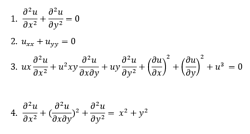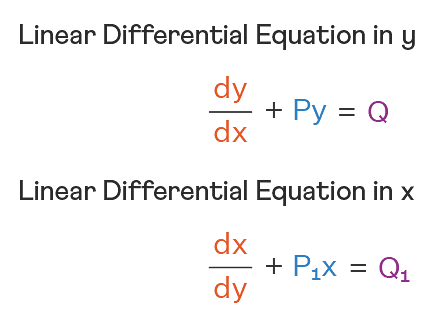Let the solution curve of the differential equation \(x\frac{dy}{dx}-y=\sqrt{y^2+16x^2},\) y(1) = 3 be y = y(x). Then y(2) is equal to
- 15
- 11
- 13
- 17
The Correct Option is A
Solution and Explanation
The correct option is(A): 15
\(x\frac{dy}{dx}-y=\sqrt{y^2+16x^2}\)
y = 4x tan θ
log |secθ + tanθ| = log |x| + C
y(1) = 3 ⇒ 3 = 4 tanθ
⇒ C = ln 2
∴ |secθ + tanθ| = 2|x|
To find y(2) put x = 2
⇒tanθ= \(\frac{y}{8}\)
(secθ + tanθ)2 = 16
⇒ y = 15
Top Questions on types of differential equations
- If \( (2,3) \) is the focus and \( x - y + 3 = 0 \) is the directrix of a parabola, then the equation of the tangent drawn at the vertex of the parabola is:
- TS EAMCET - 2024
- Mathematics
- types of differential equations
- If the focus of an ellipse is \((-1,-1)\), equation of its directrix corresponding to this focus is \(x + y + 1 = 0\) and its eccentricity is \(\frac{1}{\sqrt{2}}\), then the length of its major axis is:
- TS EAMCET - 2024
- Mathematics
- types of differential equations
- If \( m_1 \) and \( m_2 \) are the slopes of the direct common tangents drawn to the circles \[ x^2 + y^2 - 2x - 8y + 8 = 0 \quad \text{and} \quad x^2 + y^2 - 8x + 15 = 0 \] then \( m_1 + m_2 \) is:
- TS EAMCET - 2024
- Mathematics
- types of differential equations
- The equation of the common tangent to the parabola \(y^2 = 8x\) and the circle \(x^2 + y^2 = 2\) is \(ax + by + 2 = 0\). If \(-\frac{a}{b}>0\), then \(3a^2 + 2b + 1 =\)
- TS EAMCET - 2024
- Mathematics
- types of differential equations
- The axis of a parabola is parallel to Y-axis. If this parabola passes through the points \( (1,0), (0,2), (-1,-1) \) and its equation is \( ax^2 + bx + cy + d = 0 \), then \( \frac{ad}{bc} \) is:
- TS EAMCET - 2024
- Mathematics
- types of differential equations
Questions Asked in JEE Main exam
- HA $ (aq) \rightleftharpoons H^+ (aq) + A^- (aq) $ The freezing point depression of a 0.1 m aqueous solution of a monobasic weak acid HA is 0.20 °C. The dissociation constant for the acid is Given: $ K_f(H_2O) = 1.8 \, \text{K kg mol}^{-1} $, molality ≡ molarity
- JEE Main - 2025
- Colligative Properties
Let a line passing through the point $ (4,1,0) $ intersect the line $ L_1: \frac{x - 1}{2} = \frac{y - 2}{3} = \frac{z - 3}{4} $ at the point $ A(\alpha, \beta, \gamma) $ and the line $ L_2: x - 6 = y = -z + 4 $ at the point $ B(a, b, c) $. Then $ \begin{vmatrix} 1 & 0 & 1 \\ \alpha & \beta & \gamma \\ a & b & c \end{vmatrix} \text{ is equal to} $
- JEE Main - 2025
- 3D Geometry
- If the equation of the parabola with vertex $\left(\frac{3}{2},\, 3\right)$ and the directrix $x + 2y = 0$ is
$$ ax^2 + by^2 - cxy - 30x - 60y + 225 = 0, $$ then $\alpha + \beta + \gamma$ is equal to:- JEE Main - 2025
- Calculus
- Which of the following binary mixture does not show the behavior of minimum boiling azeotropes?
- JEE Main - 2025
- Solutions
Resonance in X$_2$Y can be represented as

The enthalpy of formation of X$_2$Y is 80 kJ mol$^{-1}$, and the magnitude of resonance energy of X$_2$Y is:- JEE Main - 2025
- Chemical bonding and molecular structure
Concepts Used:
Types of Differential Equations
There are various types of Differential Equation, such as:
Ordinary Differential Equations:
Ordinary Differential Equations is an equation that indicates the relation of having one independent variable x, and one dependent variable y, along with some of its other derivatives.
\(F(\frac{dy}{dt},y,t) = 0\)
Partial Differential Equations:
A partial differential equation is a type, in which the equation carries many unknown variables with their partial derivatives.

Linear Differential Equations:
It is the linear polynomial equation in which derivatives of different variables exist. Linear Partial Differential Equation derivatives are partial and function is dependent on the variable.

Homogeneous Differential Equations:
When the degree of f(x,y) and g(x,y) is the same, it is known to be a homogeneous differential equation.
\(\frac{dy}{dx} = \frac{a_1x + b_1y + c_1}{a_2x + b_2y + c_2}\)
Read More: Differential Equations